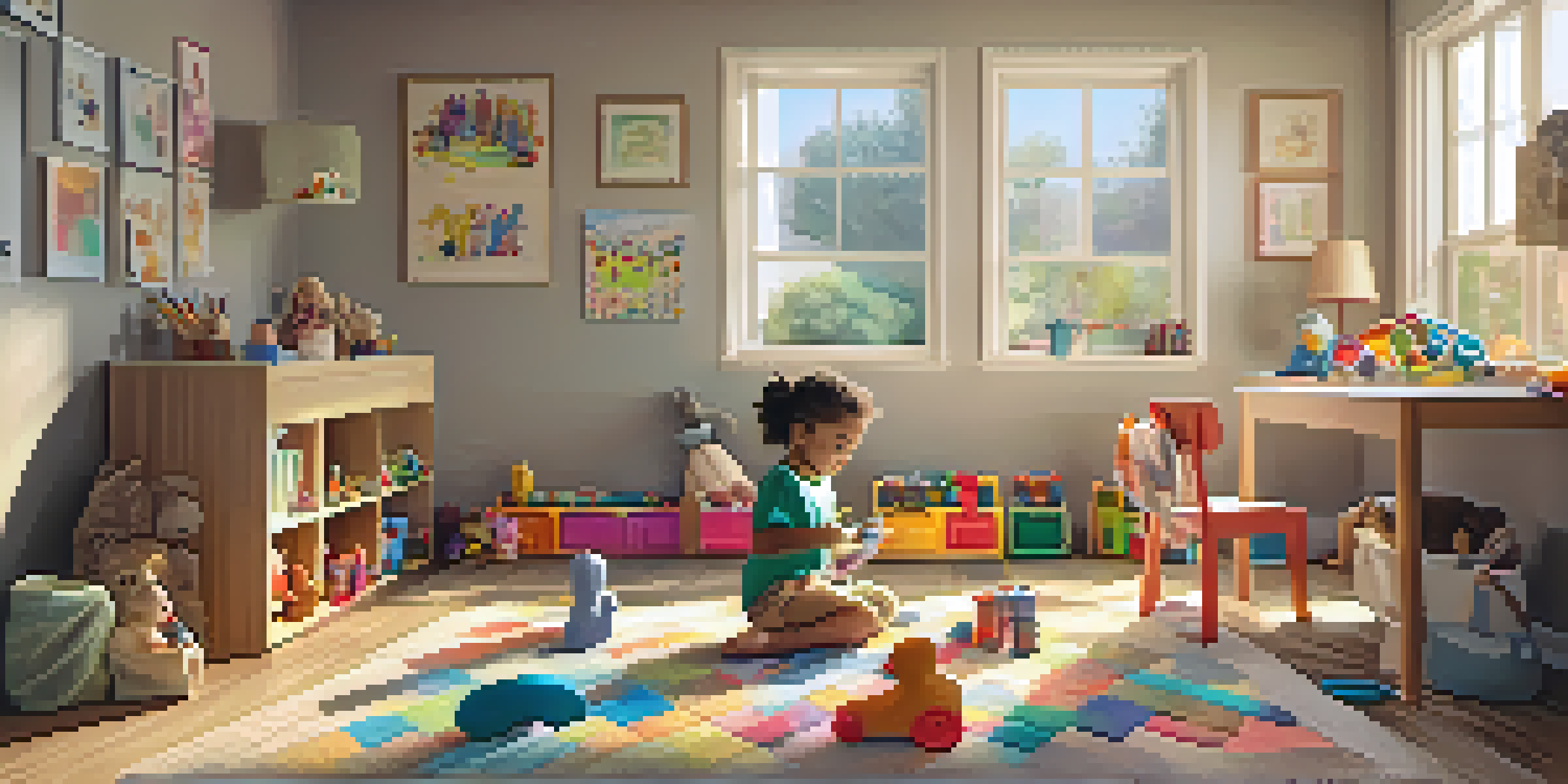Understanding the Role of Play Therapy for Youth Mental Health

What is Play Therapy and Its Importance?
Play therapy is a therapeutic approach that uses play as a means of communication and expression for children. Kids often struggle to articulate their feelings, and play provides a natural outlet for them to explore emotions and experiences. Through toys, games, and creative activities, children can simulate real-life scenarios, making it easier for them to process complex feelings.
Play is the highest form of research.
This method is especially beneficial for youth dealing with trauma, anxiety, or behavioral issues. By engaging in play, children can project their feelings onto the toys, allowing therapists to gain insight into their emotional world. This approach is not just about fun; it’s a powerful tool for healing and understanding.
Furthermore, play therapy creates a safe space where children feel comfortable expressing themselves. Just like adults might use journaling or art therapy, kids can convey their thoughts and struggles through play, making it an essential component of youth mental health treatment.
How Does Play Therapy Work?
Play therapy typically involves a trained therapist who guides the child through various play activities. The therapist observes the child’s interactions with toys, which can reveal underlying issues or emotions that need to be addressed. For example, a child playing with dolls might act out a family scenario, highlighting feelings related to family dynamics or conflict.

Using techniques such as storytelling or role-playing, therapists help children explore their feelings in a constructive manner. This hands-on approach allows kids to navigate their experiences, offering them a sense of control in situations where they might feel powerless. The therapist’s role is to facilitate and support the child's explorations, creating a therapeutic alliance that fosters trust.
Play Therapy Facilitates Expression
Using play as a communication tool helps children articulate complex feelings and experiences.
Moreover, play therapy is adaptable; it can accommodate various age groups and individual needs. Whether a child uses art supplies to express themselves or engages in structured games, the versatility of play therapy makes it an effective treatment option for diverse youth populations.
Benefits of Play Therapy for Youth Mental Health
One of the primary benefits of play therapy is that it helps children develop coping skills. By engaging in play, children can experiment with different scenarios and outcomes, enabling them to learn how to manage their emotions effectively. For instance, a child might role-play a situation where they feel anxious, helping them to practice coping mechanisms in a safe environment.
Children learn as they play. Most importantly, in play, children learn how to learn.
Additionally, play therapy fosters emotional resilience. As children confront their feelings during play, they learn to express themselves and understand their emotions better. This emotional literacy is crucial for their overall mental health and can lead to improved social interactions and relationships.
Lastly, play therapy can lead to significant behavioral improvements. Children who might have exhibited aggressive or withdrawn behaviors often show positive changes as they learn to express their emotions constructively. This transformation can result in a more harmonious home and school environment.
The Role of the Therapist in Play Therapy
Therapists play a crucial role in the effectiveness of play therapy. They are not just facilitators; they are trained professionals who understand child development and the therapeutic process. Their ability to build rapport with the child is vital, as trust is the foundation of any therapeutic relationship.
Therapists also interpret the child’s play, identifying themes and patterns that might indicate deeper emotional issues. For example, if a child consistently depicts conflict in their play scenarios, the therapist can gently guide conversations to address those feelings. This interpretation helps in tailoring the therapy to the child's unique needs.
Therapists are Key to Success
Trained therapists build trust and interpret children's play to address underlying emotional issues.
Moreover, therapists collaborate with parents and guardians to ensure that the child receives comprehensive support. By providing insights and strategies for parents, therapists extend the benefits of play therapy beyond the therapy sessions, creating a supportive environment for the child’s growth and healing.
Common Misconceptions About Play Therapy
One common misconception about play therapy is that it's merely 'playtime' without structure. In reality, play therapy is a highly structured therapeutic approach guided by trained professionals. While play is the medium, the goals and outcomes are thoughtfully planned and carefully executed to promote emotional healing.
Another myth is that play therapy is only for younger children. While it's particularly effective for preschoolers and early elementary-aged kids, adolescents can also benefit from play therapy techniques. Teenagers might engage in more complex activities like art or drama therapy that still embody the principles of play therapy, allowing them to explore their emotions in a relatable way.
Lastly, some might think that play therapy is ineffective or just a trend. However, numerous studies and clinical experiences show its efficacy in improving mental health outcomes for children. As awareness of mental health grows, so does recognition of play therapy as a valuable tool in supporting youth.
Integrating Play Therapy with Other Therapeutic Approaches
Play therapy doesn’t exist in a vacuum; it can be integrated with other therapeutic approaches to enhance its effectiveness. For instance, combining play therapy with cognitive-behavioral therapy (CBT) can provide a comprehensive framework for addressing both emotional and behavioral issues. While play therapy focuses on emotional expression, CBT can help children develop practical skills to manage their thoughts and behaviors.
In addition, art therapy is another complementary approach that can enrich the therapeutic experience. While play therapy uses toys and games, art therapy allows children to express their feelings through drawings or crafts. This integration provides multiple avenues for self-expression, catering to different preferences and needs.
Myths Surrounding Play Therapy
Common misconceptions include viewing play therapy as unstructured playtime, whereas it is a structured therapeutic approach.
Furthermore, collaboration with schools and community programs can extend the benefits of play therapy beyond individual sessions. By creating supportive environments in schools, children can practice the skills learned in therapy, fostering a holistic approach to mental health.
Finding a Play Therapist: What to Look For
When seeking a play therapist, it’s essential to look for someone with proper credentials and experience in child psychology. A licensed therapist specializing in play therapy should have a strong background in child development and various therapeutic techniques. This expertise is crucial in ensuring that the therapist can effectively address the unique needs of the child.
Additionally, consider the therapist's approach and style. It’s important that the therapist creates a warm, welcoming environment where children feel safe to express themselves. An initial consultation can help gauge whether the therapist's style aligns with your child's needs and comfort level.

Finally, trust your instincts as a parent or guardian. The therapeutic relationship is vital for success, so it's important to find someone you feel comfortable with. Open communication with the therapist about your child's needs and progress will further enhance the effectiveness of the therapy.